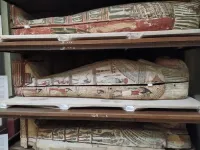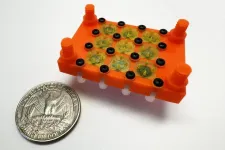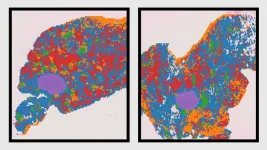(Press-News.org) UCL Press Release
Under embargo until Friday 14 February 2025, 00:01 UK time / 19:01 Thursday 13 February US Eastern time
Ancient Egyptian mummified bodies smell ‘woody,’ ‘spicy’ and ‘sweet’, finds a new study led by researchers from UCL and the University of Ljubljana, revealing new details about mumification practices.
The research, published in Journal of the American Chemical Society, is the first time that the smells of mummified bodies have been systematically studied combining a mix of instrumental and sensory techniques, including an electronic ‘nose’ and trained, human ‘sniffers.’ Nine ancient Egyptian mummified bodies were studied.
This new data offers clues about the materials used in mummification and how practices and ingredients evolved, as well as reveal details about how museums have subsequently conserved the remains.
It’s hoped that using this kind of chemical analysis can help keep conservators safe, protect ancient artifacts and preserve their olfactory heritage.
Lead author, Professor Matija Strlič (UCL Bartlett School Environment, Energy & Resources and the University of Ljubljana) said: “The smell of mummified bodies has for years attracted significant interest from experts and the general public, but no combined chemical and perceptual scientific study has been conducted until now. This ground-breaking research really helps us better plan conservation and understand the ancient embalming materials. It adds another layer of data to enrich the museum exhibition of mummified bodies.”
Dr Cecilia Bembibre (UCL Bartlett School of Environment, Energy & Resources), added: “Two aspects of this study stand out to me. First, new information was revealed by the smells, highlighting the importance of using our senses to understand the past.
“Secondly, while most of the studies on mummified bodies have taken place in European museums so far, here we worked closely with Egyptian colleagues to ensure their expertise and perceptual experience were represented, and we jointly developed an ethical and respectful approach to studying the mummified bodies.”
Odours are chemical molecules suspended in air that have been given off by a substance. The researchers used a gas chromatograph coupled with a mass spectrometer to measure and quantify chemicals emitted by nine ancient Egyptian mummified bodies on display and in storage in the Egyptian Museum in Cairo. In addition, a panel of trained human ‘sniffers’ described the smells in terms of quality, intensity, and pleasantness.
By combining these methods, the researchers were able to identify whether a smell chemical was emitted by the archaeological item, from conservation products or pesticides that may have been added later, or from the item’s natural deterioration over the years because of moulds, bacteria and other microorganisms. The research demonstrated the effectiveness of odour as a non-invasive and non-destructive method to chemically categorise and analyse ancient remains.
In addition to gaining a deeper insight into the conservation and material history of ancient mummified bodies, the research will enable museums to engage audiences not just visually, but using their noses as well by creating ‘smellscapes.’ In the future, a contemporary reconstruction of the smell of ancient mummified bodies will be produced by the research team, which will enable audiences to experience this important aspect of ancient Egyptian heritage, and approach practices of embalming and conservation in an engaging, olfactory way.
Co-author, Professor Ali Abdelhalim, director of the Egyptian Museum in Cairo, said: “To the ancient Egyptians, mummification was an important mortuary practice aimed at preserving the body and soul for the afterlife through a detailed ritual of embalming of the deceased using oils, waxes and balms. The practice evolved over time, and identifying different techniques and materials used offers insights into the era, location and socioeconomic status of the individual being mummified.”
Smell was a key consideration for the ancient Egyptians during the mummification process, as pleasant odours were associated with the bodies of deities and their purity, while foul odours were considered indications of a body’s corruption and decay. Even today, about 5,000 years later, conservators often describe the aroma of these mummified bodies as ‘pleasant,’ as it is the product of coniferous resins and oils (such as pine, cedar, and juniper), gum resins (like myrrh and frankincense), and waxes.
The research was conducted in collaboration between conservators and curators at the Egyptian Museum in Cairo and researchers from Slovenia, Poland and the UK.
Notes to Editors
For more information or to speak to the researchers involved, please contact Michael Lucibella, UCL Media Relations. T: +44 (0)75 3941 0389, E: m.lucibella@ucl.ac.uk
Emma Paolina, et al, ‘Ancient Egyptian Mummified Bodies: Cross-disciplinary Analysis of Their Smell’ will be published in Journal of the American Chemical Society on Friday 14 February, 00:01 UK time, 19:01 Thursday 13 February US Eastern time, and is under a strict embargo until this time.
The DOI for this paper will be 10.1021/jacs.4c15769
Additional material
Images, video and captions/credit can be downloaded from this link.
Links
Professor Matija Strlic's academic profile
Dr Cecilia Bembribre Jacobo's academic profile
UCL Bartlett Institute for Sustainable Heritage
UCL Bartlett School of Environment, Energy & Resources
UCL Bartlett Faculty of the Built Environment
University of Ljubljana
Egyptian Museum in Cairo
About UCL – London’s Global University
UCL is a diverse global community of world-class academics, students, industry links, external partners, and alumni. Our powerful collective of individuals and institutions work together to explore new possibilities.
Since 1826, we have championed independent thought by attracting and nurturing the world's best minds. Our community of more than 50,000 students from 150 countries and over 16,000 staff pursues academic excellence, breaks boundaries and makes a positive impact on real world problems.
The Times and Sunday Times University of the Year 2024, we are consistently ranked among the top 10 universities in the world and are one of only a handful of institutions rated as having the strongest academic reputation and the broadest research impact.
We have a progressive and integrated approach to our teaching and research – championing innovation, creativity and cross-disciplinary working. We teach our students how to think, not what to think, and see them as partners, collaborators and contributors.
For almost 200 years, we are proud to have opened higher education to students from a wide range of backgrounds and to change the way we create and share knowledge.
We were the first in England to welcome women to university education and that courageous attitude and disruptive spirit is still alive today. We are UCL.
www.ucl.ac.uk | Follow @uclnews.bsky.social on Bluesky | Read news at www.ucl.ac.uk/news/ | Listen to UCL podcasts on SoundCloud | View images on Flickr | Find out what’s on at UCL Mind
END
Ancient Egyptian mummified bodies smell ‘woody,’ ‘spicy’ and ‘sweet’
Ancient Egyptian mummified bodies smell ‘woody,’ ‘spicy’ and ‘sweet’, finds a new study led by researchers from UCL and the University of Ljubljana, revealing new details about mumification practices
2025-02-14
ELSE PRESS RELEASES FROM THIS DATE:
MIT engineers develop a fully 3D-printed electrospray engine
2025-02-13
CAMBRIDGE, MA – An electrospray engine applies an electric field to a conductive liquid, generating a high-speed jet of tiny droplets that can propel a spacecraft. These miniature engines are ideal for small satellites called CubeSats that are often used in academic research.
Since electrospray engines utilize propellant more efficiently than the powerful, chemical rockets used on the launchpad, they are better suited for precise, in-orbit maneuvers. The thrust generated by an electrospray emitter is tiny, so electrospray engines typically use an array of emitters that are uniformly ...
Speculum exams unnecessary for HPV screening
2025-02-13
Genital human papillomavirus is the most common sexually transmitted infection in the United States and is thought to be responsible for more than 99% of cervical cancers.
HPV screening usually entails a speculum-based exam, which is an uncomfortable experience for most patients, especially those who have physical disabilities.
In two studies, published in Preventive Medicine Reports and JAMA Network Open, University of Michigan researchers are the first to demonstrate in the U.S. that self-sampling is just as effective as speculum-based testing for HPV detection.
Most people who have HPV are usually unaware that they have it.
By ...
Reduced prediabetes in people who ate broccoli compound
2025-02-13
The chemical compound sulforaphane found in broccoli sprouts can be linked to improved blood sugar levels in prediabetes, a precursor to type 2 diabetes. This has been shown in a study conducted at the University of Gothenburg. The broccoli compound had a more significant effect on blood sugar levels in certain people.
Researchers at the University of Gothenburg have previously identified sulforaphane as an antidiabetic agent in type 2 diabetes. A patient study conducted in 2017 demonstrated significantly lower blood sugar in people with diabetes after they took large ...
Landmark atlas reveals how aging breast tissue shapes breast cancer risk
2025-02-13
Aging is a privilege, but it also brings risks—including an increased likelihood of developing age-related diseases including cancer. Researchers at The Jackson Laboratory (JAX) have created a landmark atlas of how healthy breast tissue ages, revealing key cellular, molecular, and genetic changes that may tip the balance toward breast cancer development. Their findings, published recently in Nature Aging, provide a valuable open-access resource for the scientific community to explore aging and its role in increased cancer risk.
Rewriting ...
SHEA supports key federal advisory committees
2025-02-13
The Society for Healthcare Epidemiology of America (SHEA) urges incoming Secretary of the U.S. Department of Health and Human Services, Robert F. Kennedy Jr., to resume the federal advisory committees for key health-related priority issues as provided under the Federal Advisory Committees Act. Federal advisory committees are an important aspect of the deliberative process for reviewing important scientific information among federal agencies and members of the public as new evidence becomes available. The ability for members ...
Neurologic complications of flu nearly 50 times greater for children with underlying neurologic conditions
2025-02-13
Many clinicians do not consider neurologic complications of the flu when discussing vaccination or treatment of influenza with families.
A recent study that explored the neurologic impact of flu in children aims to change that.
“Serious Neurologic Events with Seasonal Influenza in Young Children,” published in Academic Pediatrics, the official journal of the Academic Pediatric Association, looked at the population-based incidence of underrecognized influenza-associated serious neurologic events in children less than 5 years of age.
While serious neurologic complications are uncommon in young children, the study showed a much higher incidence, ...
Killing H5N1 in waste milk — an alternative to pasteurization
2025-02-13
Pasteurization is the only widely recognized method of killing H5N1, the virus that causes bird flu, in milk. However, pasteurization can be expensive and fewer than 50% of large dairy farms pasteurize waste milk.
Waste milk includes colostrum, the first milk after calving; milk from cows treated with antibiotics or other drugs; or any other factor that can make milk unsuitable and unsellable for human consumption. On farms, raw waste milk poses a potential risk of spreading avian flu, which so far has been confirmed ...
NTT Research and Harvard scientists optimize biohybrid ray development with machine learning
2025-02-13
The Harvard John A. Paulson School of Engineering and Applied Sciences (SEAS) and NTT Research, Inc., a division of NTT, announced the publication of research showing an application of machine-learning directed optimization (ML-DO) that efficiently searches for high-performance design configurations in the context of biohybrid robots. Applying a machine learning approach, the researchers created mini biohybrid rays made of cardiomyocytes (heart muscle cells) and rubber with a wingspan of about 10 mm that are approximately two times more efficient at swimming than those recently ...
Mapping connections in a neuronal network
2025-02-13
Harvard researchers have mapped and catalogued more than 70,000 synaptic connections from about 2,000 rat neurons, using a silicon chip capable of recording small yet telltale synaptic signals from a large number of neurons.
The research, published in Nature Biomedical Engineering, is a major advance in neuronal recording and may help bring scientists a step closer to drawing a detailed synaptic connection map of the brain.
Higher-order brain functions are believed to be derived from the ways brain ...
Study: Air pollution exposure late in pregnancy increases NICU admission risk
2025-02-13
BUFFALO, N.Y. – Air pollution caused by auto emissions, wildfires and other sources is problematic for many people. It’s of particular concern for pregnant people due to the impact pollutants can have on the fetus, especially in the final month before birth.
A new study from the University at Buffalo offers insight into air pollution’s effects during this vulnerable time by measuring neonatal intensive care unit (NICU) admissions and satellite-based air pollution data.
The researchers focused on common pollutants, such as nitrogen dioxide (NO2), which is caused primarily by the burning of fossil fuels in vehicles, industrial processes and power plants, and PM2.5, which ...
LAST 30 PRESS RELEASES:
Making lighter work of calculating fluid and heat flow
Normalizing blood sugar can halve heart attack risk
Lowering blood sugar cuts heart attack risk in people with prediabetes
Study links genetic variants to risk of blinding eye disease in premature infants
Non-opioid ‘pain sponge’ therapy halts cartilage degeneration and relieves chronic pain
AI can pick up cultural values by mimicking how kids learn
China’s ecological redlines offer fast track to 30 x 30 global conservation goal
Invisible indoor threats: emerging household contaminants and their growing risks to human health
Adding antibody treatment to chemo boosts outcomes for children with rare cancer
Germline pathogenic variants among women without a history of breast cancer
Tanning beds triple melanoma risk, potentially causing broad DNA damage
Unique bond identified as key to viral infection speed
Indoor tanning makes youthful skin much older on a genetic level
Mouse model sheds new light on the causes and potential solutions to human GI problems linked to muscular dystrophy
The Journal of Nuclear Medicine ahead-of-print tip sheet: December 12, 2025
Smarter tools for peering into the microscopic world
Applications open for funding to conduct research in the Kinsey Institute archives
Global measure underestimates the severity of food insecurity
Child survivors of critical illness are missing out on timely follow up care
Risk-based vs annual breast cancer screening / the WISDOM randomized clinical trial
University of Toronto launches Electric Vehicle Innovation Ontario to accelerate advanced EV technologies and build Canada’s innovation advantage
Early relapse predicts poor outcomes in aggressive blood cancer
American College of Lifestyle Medicine applauds two CMS models aligned with lifestyle medicine practice and reimbursement
Clinical trial finds cannabis use not a barrier to quitting nicotine vaping
Supplemental nutrition assistance program policies and food insecurity
Switching immune cells to “night mode” could limit damage after a heart attack, study suggests
URI-based Global RIghts Project report spotlights continued troubling trends in worldwide inhumane treatment
Neutrophils are less aggressive at night, explaining why nighttime heart attacks cause less damage than daytime events
Menopausal hormone therapy may not pose breast cancer risk for women with BRCA mutations
Mobile health tool may improve quality of life for adolescent and young adult breast cancer survivors
[Press-News.org] Ancient Egyptian mummified bodies smell ‘woody,’ ‘spicy’ and ‘sweet’Ancient Egyptian mummified bodies smell ‘woody,’ ‘spicy’ and ‘sweet’, finds a new study led by researchers from UCL and the University of Ljubljana, revealing new details about mumification practices








